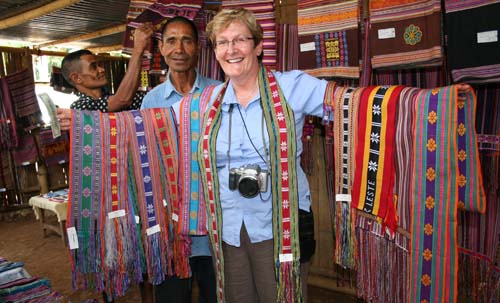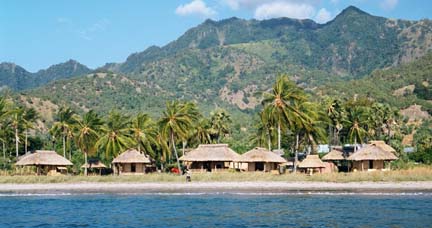
Eleven years after voting overwhelmingly for independence, the East Timorese people, supported by their government and local NGOs, are opening their doors to the world and embracing tourism. Kim Bowden reports.
East Timor has had its fair share of foreign visitors but most did not stop over for a holiday.
First the Portuguese colonisers arrived, four centuries later the Indonesians invaded, and most recently hordes of NGO workers, military contingents and church groups have flooded the country in the name of aid and nation-building.
But more recently holiday-makers have started trickling into the fledgling nation. And this time around the influx is on East Timorese terms.
According to Dili’s Turismo de Timor-Leste close to 30,000 people arrived in the country on a tourist visa last year, more than three times the number of tourist arrivals than in 2006 when the statistics started.
Eleven years after voting overwhelmingly for independence, the East Timorese people, supported by their government and local NGOs, are opening their doors to the world and embracing tourism.
Tourism Minister Gil da Costa Alves says East Timor’s tourism sector has enormous potential to generate income for the impoverished country as well as healing a national psyche damaged by years of isolation and occupation.
“All of us know that tourism is one of the biggest industries in the world; it is not only an effective tool for supporting economic growth but also acts as a bridge for peace,” he says in a statement on his ministry’s military website.
‘Peace industry’
His colleague, East Timor National Director of Tourism Jose Quintas, agrees, saying tourism is the world’s “peace industry”.
Quintas says the recent past has been difficult and the country is still undergoing a reconstruction and development process. He sees tourism as one of the tools to ensure this development is both economically and socially sustainable.
East Timor tourism pioneer Jane Crouch says she didn’t even mention the word “tourism” when she visited the country in September 2002 on a mission to gauge whether its residents were ready and willing to welcome groups of travellers.
Crouch, the responsible travel manager for Australian adventure travel operator Intrepid Travel, says she explained to locals “this is about people coming into your life and making friends with you”.
Visitors going off their own bat with no other obligation than simply the desire to explore, enjoy and discover East Timor cannot be “compared to United Nations forces, NGOs or any other foreign invasion”, says the 14-year veteran of developing world tourism.
She says she half expected people to say “that’s enough, we have had enough”.
Instead she received a “phenomenally positive response”.
“They had been cut off from the outside world for so long, they said: ‘Yes we would be interested in meeting people’.”
Feted tour group
Crouch returned to East Timor in May 2003 with Intrepid Travel’s inaugural group of travellers, who snatched up the 12 available spaces on the trip within 24 hours of them going on sale.
“We were feted as the first tour group in the free and independent East Timor.”
There was dancing and serenading as the intrepid travellers traversed the country and the group was even invited to a reception with newly installed government dignitaries, says Crouch, who was the group’s tour leader.
“There was an incredible welcome everywhere…And that first group had some pretty amazing experiences.”
Intrepid Travel completed nine 15-day trips to East Timor between May 2003 and May 2006, when they were forced to suspend trips due to political upheaval.
The situation went from bad to worse in February 2008, when President Jose Ramos-Horta was shot in an assassination attempt, which did nothing to paint a picture-postcard image of the country.
The threat of “Delhi belly” or dengue fever in Asia-Pacific tourist hotspots rarely distracts the average tourist from the allure of tropical sunsets and pina coladas. Consular advice suggests travellers to East Timor however need to carefully consider their holiday choice.
‘Fragile security’
The New Zealand Ministry of Foreign Affairs and Trade cautions Kiwis “there is some risk to their security in East Timor due to the fragile security situation”.
Australian consular advice goes a step further, asking its nationals to “exercise a high degree of caution in East Timor because of the uncertain security situation and the possibility of civil unrest”.
It says: “The situation could deteriorate without warning.”
However a recent reduction of troops in the Australian-New Zealand International Stabilisation Force (ISF), commissioned to Timor in the aftermath of the 2006 unrest, suggests an improving security situation.
In May this year the New Zealand Defence Force confirmed they had 80 personnel stationed in East Timor, down from an initial 140-strong team.
Earlier this year, the Australian Defence Force also reduced its personnel numbers in the ISF to around 400.
Last month, Intrepid Travel relaunched their East Timor itinerary. So far two trips have gone off without a hitch, another is scheduled for September and Crouch is hopeful up to six trips will depart next year.
Optimistic future
Lee Tan, Asia Pacific coordinator with the Australian Conservation Foundation (ACF), which supports local East Timorese organisations to balance development with protection of their natural resources, is also optimistic about the future of tourism in East Timor.
Tan says she has a long history with East Timor, which goes back beyond her present role. A close friend was killed by Indonesian troops in the infamous massacre of peaceful protesters in Santa Cruz cemetery in Dili in 1991.
“East Timor has a very high profile for such a small nation. It has a strong history of local resistance against military clout.”
Now the East Timorese are free from Indonesian rule it is vital they find their own development pathway, she says.
After independence local community groups approached the ACF and asked for help “to build their nation in a way that is sustainable”, says Tan.
“We did not suggest it. The Timorese themselves wanted to explore it.
“The Timorese need to be supported; it has to happen at their own pace…they are used to a particular way of life.”
Tan is realistic about the potential effects of tourism.
Sound eco-tourism
“Let’s face it tourism is not all nice and glorious. Some forms are exploitative and do not bring benefits to locals,” says Tan.
But the conservation advocate says East Timor is heading in the right direction.
The ACF has worked with the Haburas Foundation, which was formed by a group of Timorese students in 1998 and is the most active national environmental group in the country.
“We are helping them with land use planning, making sure eco-tourism is ecologically sound and equally, socially sound,” says Tan.
Haburas has successfully lobbied the government, showcasing grassroots tourism success stories, and as a result the Ministry of Tourism is making it a priority to include community-based tourism in their plans, says Tan. Tua Koin eco-village on Atauro Island is one such success story. Operated by island-based NGO Roman Luan, this eco-village has simple thatched-roof bungalow, runs on solar power and recycles grey water.
Tua Koin eco-village on Atauro Island is one such success story. Operated by island-based NGO Roman Luan, this eco-village has simple thatched-roof bungalow, runs on solar power and recycles grey water.
The village’s basic website says: “The people of the Atauro Island community in East Timor invite you to come and visit their island , a magical place that is still ‘like other places used to be’ and to be part of their project to keep it that way.”
Subsistence farmers
Most of the 8000 people on Atauro are subsistence farmers and fishers, and all profits from Tua Koin are reinvested into community projects. Tan says money generated by the tourism venture recently funded a new teacher’s living quarters at the local high school.
The eco-village also provides local people with training opportunities in hospitality.
Intrepid’s Crouch says personal development opportunities such as this are one of the real benefits from an increase in foreign visitors.
“Friendship and connections after such a long time of isolation help to give East Timorese aspirations and hope for a better future.”
Last month Crouch handed over the tour leading reigns after selecting a protégé from an enthusiastic group of local drivers and guides who had worked with the travel company and were keen to advance their position.
“He will need a fair bit of support from Intrepid especially to build confidence and organisational skills,” she says.
Crouch is an advocate for developing world travel which provides direct benefits to local communities.
Weaving collective
Intrepid Travel groups visit a weaving collective in the remote village of Home, where traditional tais (weavings) are available for purchase.
Most of the weavers are widows of men killed in fighting with Indonesia during the struggle for independence and Crouch says traveller’s “financial contribution can be quickly significant” in a community where it is a “real struggle to make ends meet”.
“They are able to sell to us directly without any middleman,” she says.
Backpacker gospel, the Lonely Planet Guide to East Timor warns: “Traditional arts have taken a beating during the last few decades…a few faux tais have been noted; imported from china.”
By showing an interest in traditional crafts, tourists are helping to preserve cultural heritage.
Just returned from East Timor, Crouch was encouraged by the increase in tours and independent travellers she encountered.
“I came across five pairs of people independently cycling around…fantastic.”
She says the government-sponsored Tour de Timor cycling event, held for the first time last year, generated international publicity.
“It told the world that this place is beautiful and safe.”
Kim Bowden is a Postgraduate Diploma in Communication Studies student on the Asia-Pacific Journalism course at AUT University.


